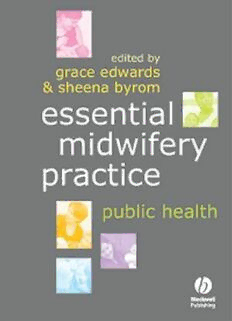
Essential Nuclear Medicine Physics, Second Edition PDF
Preview Essential Nuclear Medicine Physics, Second Edition
Essential Nuclear Medicine Physics To my two nuclear families: Ronald, Arianna, To Rhoda M. Powsner, M.D., J.D. for her love, and Danny, and Edward, Rhoda, Seth, Ethan, support,andhercontinuinghelp. andDavid,fortheirloveandsupport. ERP RAP SECOND EDITION Essential Nuclear Medicine Physics Rachel A. Powsner M.D. AssociateProfessorofRadiology BostonUniversitySchoolofMedicine Director,DivisionofNuclearMedicine DepartmentofRadiology BostonVeteransAdministrationHealthcareSystem Boston,Massachusetts Edward R. Powsner M.D. FormerChief,NuclearMedicineService,VeteransAdministrationHospital AllenPark,Michigan FormerProfessorandAssociateChairman,DepartmentofPathology MichiganStateUniversity EastLansing,Michigan FormerChair,JointReviewCommitteeforEducationalNuclearMedicineTechnology FormerMember,AmericanBoardofNuclearMedicine ©2006RachelA.PowsnerandEdwardR.Powsner PublishedbyBlackwellPublishingLtd BlackwellPublishing,Inc.,350MainStreet,Malden,Massachusetts02148-5020,USA BlackwellPublishingLtd,9600GarsingtonRoad,OxfordOX42DQ,UK BlackwellPublishingAsiaPtyLtd,550SwanstonStreet,Carlton,Victoria3053,Australia TherightoftheAuthortobeidentifiedastheAuthorofthisWorkhasbeenassertedin accordancewiththeCopyright,DesignsandPatentsAct1988. Allrightsreserved.Nopartofthispublicationmaybereproduced,storedinaretrieval system,ortransmitted,inanyformorbyanymeans,electronic,mechanical,photocopying, recordingorotherwise,exceptaspermittedbytheUKCopyright,DesignsandPatentsAct 1988,withoutthepriorpermissionofthepublisher. Firsteditionpublished1998 Secondeditionpublished2006 1 2006 LibraryofCongressCataloging-in-PublicationData Powsner,RachelA. Essentialnuclearmedicinephysics/RachelA.Powsner,EdwardR.Powsner.–2nded. p.;cm. Rev.ed.of:Essentialsofnuclearmedicinephysics.1998. Includesindex. ISBN-13:978-1-4051-0484-5(alk.paper) ISBN-10:1-4051-0484-8(alk.paper) 1.Nuclearmedicine.2.Medicalphysics.I.Powsner,EdwardR.,1926-.II.Powsner, RachelA.,Essentialsofnuclearmedicinephysics.III.Title. [DNLM:1.NuclearMedicine.2.Accidents,Radiation–prevention&control.3.Nuclear Physics.4.RadiationEffects.5.Radiation. WN440P889e2006] R895.P692006 616.07’575–dc22 2005035905 AcataloguerecordforthistitleisavailablefromtheBritishLibrary Setin9/13ptPalatinobyNewgenImagingSystems(P)Ltd.,Chennai,India PrintedandboundinReplikaPressPvtLtd,Haryana,India CommissioningEditor:MartinSugden DevelopmentEditor:LaurenBrindley ProductionController:KateCharman EditorialAssistant:EleanorBonnet ForfurtherinformationonBlackwellPublishing,visitourwebsite: www.blackwellpublishing.com Thepublisher’spolicyistousepermanentpaperfrommillsthatoperateasustainable forestrypolicy,andwhichhas beenmanufacturedfrompulpprocessedusingacid-free andelementarychlorine-freepractices.Furthermore,thepublisherensuresthatthetext paperandcoverboardusedhavemetacceptableenvironmentalaccreditationstandards. Contents Preface,vi Acknowledgments,vii Contributingauthor,viii 1 BasicNuclearMedicinePhysics,1 2 InteractionofRadiationwithMatter,20 3 FormationofRadionuclides,29 4 NonscintillationDetectors,37 5 NonimagingScintillationDetectors,52 6 ImagingInstrumentation,65 7 Single-PhotonEmissionComputedTomography(SPECT),85 8 PositronEmissionTomography(PET),114 9 CombinedPET/CTImaging,128 10 QualityControl,136 11 RadiationBiology,151 12 RadiationDosimetry,163 13 RadiationSafety,167 14 ManagementofNuclearEventCasualties,174 R.A.Powsner,E.R.Powsner,andK.Donohoe RecommendingReading,188 AppendixA. CommonNuclides,190 AppendixB. MajorDosimetryforCommonPharmaceuticals,191 AppendixC. SampleCalculationsoftheSValue,194 AppendixD. GuidetoNuclearRegulatoryCommission(NRC) Publications,197 Answers,199 Index,203 v Preface After years of postgraduate training, many radiationbiology,radiationsafety,andradiation physicians have forgotten some (or most) of accidents. their undergraduate and high school physics Numerous illustrations are included. They and may find submersion into nuclear physics are highly schematic and are designed to illus- somewhat daunting. This book begins with trate concepts rather than represent scale mod- a very basic introduction to nuclear physics els of their subjects. This text is intended for and the interactions of radiation and matter. radiologyresidents, cardiologyfellows, nuclear It then proceeds with discussions of nuclear medicine fellows, nuclear medicine technology medicine instrumentation used for production students, and others interested in an introduc- of nuclides, measurement of doses, surveying tiontoconceptsinnuclearmedicinephysicsand radioactivity, and imaging (including SPECT, instrumentation. PET, and PET-CT). The final chapters cover RAP vi Acknowledgments The authors would like to thank the following Maura Dineen-Burton, C.N.M.T., Dipa Patel, expertsfortheirvaluablecritiquesofportionsof M.D.,AlfonseTaghian,M.D.,HernanJara,Ph.D., this text: Stephen Moore, Ph.D. on the topic of Susan Gussenhoven, Ph.D., John Shaw, M.S., SPECTprocessingincludingiterativereconstruc- MichaelSquillante,Ph.D.,KevinBuckley,C.H.P., tion, FredFahey, D.Sc. onPETinstrumentation, JayneCaruso,VictorLee,M.D.,TobyWroblicka, and Robert Zimmerman, M.S.E.E. on gamma M.D., Dan Winder, M.D., Dennis Atkinson, cameraqualitycontrolandthephysicsofcrystal M.D., and Inna Gazit, M.D.. Thanks to Peter scintillators. In addition, Dr Frank Masse gen- Shomphe,A.R.R.T.,C.N.M.T.,BobDann,Ph.D., erously reviewed the material on radiation andLaraPatriquin,M.D.forwadingthroughthe accidentsandMarkWalsh, C.H.P.critiquedthe manuscript in its entirety. We greatly appreci- radiation safety text. Many thanks to Margaret ate the patience shown at that time by Robert Nordby for her patient review of the proofs. Zimmerman, M.S.E.E., Kevin Buckley, C.H.P., TheauthorsaregratefultoRhondaM.Powsner, JohnWidman, Ph.D., C.H.P., PeterWaer, Ph.D., M.D.forherassistanceinreviewingthetextand StephenMoore, Ph.D., BillWorstell, Ph.D., and proofs. HernanJara,Ph.D.whileansweringournumer- Sincethesecondeditionincorporatesthetext ousquestions. ThankstoDeliaEdwards, Milda from the first edition the authors would like to Pitter,andPaulGuidone,M.D.fortakingtimeto thank the following individuals for their help poseasmodels. in reviewing portions of the first edition dur- RAP ing it’s preparation: David Rockwell, M.D., ERP vii Contributing author KevinDonohoe,M.D. StaffPhysicianinNuclearMedicine BethIsraelDeaconessMedicalCenter AssistantProfessorofRadiology HarvardMedicalSchool viii Essential Nuclear Medicine Physics, Second Edition Rachel A. Powsner, Edward R. Powsner Copyright © 2006 Rachel A. Powsner and Edward R. Powsner CHAPTER 1 1 Basic nuclear medicine physics theelectronsfromtheatomsofthematterinthe Properties and Structure of Matter rod to the cloth. In a similar fashion, electrons Matter has several fundamental properties. For canbetransferredtotheshoesofapersonwalk- our purposes the most important are mass and ingacrossacarpet. Thecarpetwillthenhavea charge(electric).Werecognizemassbytheforce net positive charge and the shoes (and wearer) gravity exerts on a material object (commonly anetnegativecharge(Fig.1-1).Withthesebasic referredtoasitsweight)andbytheobject’siner- propertiesinmind,wecanlookatmatterinmore tia,whichisthe“resistance”weencounterwhen detail. weattempttochangethepositionormotionofa Matteriscomposedofmolecules.Inanychem- materialobject. icallypurematerial,themoleculesarethesmall- Similarly, we can, at least at times, recognize est units that retain the characteristics of the charge by the direct effect it can have on us materialitself.Forexample,ifablockofsaltwere or that we can observe it to have on inanimate to be broken into successively smaller pieces, objects.Forexample,wemayfeelthepresenceof astronglychargedobjectwhenitcausesourhair tomoveoreventostandonend.Moreoftenthan not, however, we are insensitive to charge. But whethergrosslydetectableornot,itseffectsmust be considered here because of the role charge playsinthestructureofmatter. Chargeisgenerallythoughttohavebeenrec- ognizedfirstbytheancientGreeks.Theynoticed thatsomekindsofmatter,anamberrodforexam- ple, can be given an electric charge by rubbing it with a piece of cloth. Their experiments con- vincedthemthattherearetwokindsofcharge: opposite charges, which attract each other, and like charges, which repel. One kind of charge cametobecalledpositive,theothernegative.We nowknowthatthenegativechargeisassociated withelectrons.Therubbingtransferredsomeof Figure1-1 Electrostaticcharge. 1 2 CHAPTER 1 thesmallestfragmentwiththepropertiesofsalt areheldbytheelectricalforcebetweenthemand wouldbeasinglesaltmolecule(Fig.1-2). With thepositivenucleus.Thenucleusoftheatomis further fragmentation the molecule would no heldtogetherbyanothertypeofforce—nuclear longerbesalt.Molecules,inturn,arecomposed force—whichisinvolvedinthereleaseofatomic of atoms. Most molecules consist of more than energy.Nuclearforcesareofgreatermagnitudes one kind of atom—salt, for example, is made thanelectricalforces. upofatomsofchlorineandsodium.Theatoms themselvesarecomposedofsmallerparticles,the Elements subatomicparticles,whicharediscussedlater. Themoleculeisheldtogetherbythechemical Therearemorethan100speciesofatoms.These bondsamongitsatoms.Thesebondsareformed speciesarereferredtoaselements. Mostofthe bytheforceofelectricalattractionbetweenoppo- knownelements—forexample,mercury,helium, sitely charged parts of the molecule. This force gold,hydrogen,andoxygen—occurnaturallyon is often referred to as the Coulomb force after earth;othersarenotusuallyfoundinnaturebut CharlesA.deCoulomb,thephysicistwhochar- are made by humans—for example, europium acterizedit.Thisistheforceinvolvedinchemical andamericium.Areasonableexplanationforthe reactionssuchasthecombiningofhydrogenand absenceofsomeelementsfromnatureisthatif oxygentoformwater.Theelectronsoftheatom and when they were formed they proved too unstable to survive in detectable amounts into thepresent. All the elements have been assigned sym- bolsorabbreviatedchemicalnames: gold—Au, mercury—Hg, helium—He. Some symbols are obviousabbreviationsoftheEnglishname;oth- ersarederivedfromtheoriginalLatinnameof theelement,forexample,Auisfromaurum,the Latinwordforgold. All of the known elements, both natural and thosemadebyhumans,areorganizedintheperi- Figure1-2 TheNaClmoleculeisthesmallestunitof saltthatretainsthecharacteristicsofsalt. odictable.InFigure1-3,theelementsthathavea Figure1-3 Periodictable.
